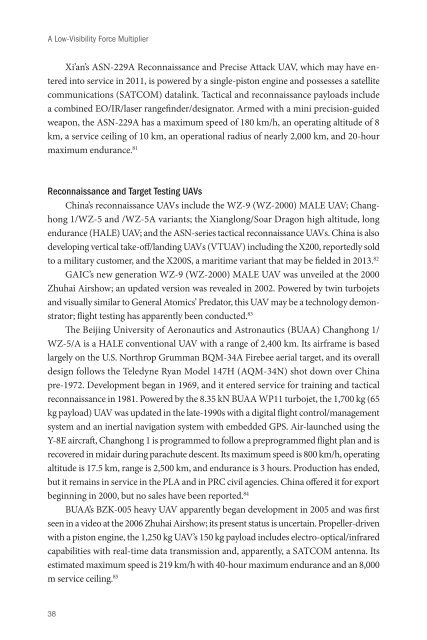Create successful ePaper yourself
Turn your PDF publications into a flip-book with our unique Google optimized e-Paper software.
A Low-Visibility Force Multiplier<br />
Xi’an’s ASN-229A Reconnaissance and Precise Attack UAV, which may have entered<br />
into service in 2011, is powered by a single-piston engine and possesses a satellite<br />
communications (SATCOM) datalink. Tactical and reconnaissance payloads include<br />
a combined EO/IR/laser rangefinder/designator. Armed with a mini precision-guided<br />
weapon, the ASN-229A has a maximum speed of 180 km/h, an operating altitude of 8<br />
km, a service ceiling of 10 km, an operational radius of nearly 2,000 km, and 20-hour<br />
maximum endurance. 81<br />
Reconnaissance and Target Testing UAVs<br />
China’s reconnaissance UAVs include the WZ-9 (WZ-2000) MALE UAV; Changhong<br />
1/WZ-5 and /WZ-5A variants; the Xianglong/Soar Dragon high altitude, long<br />
endurance (HALE) UAV; and the ASN-series tactical reconnaissance UAVs. China is also<br />
developing vertical take-off/landing UAVs (VTUAV) including the X200, reportedly sold<br />
to a military customer, and the X200S, a maritime variant that may be fielded in 2013. 82<br />
GAIC’s new generation WZ-9 (WZ-2000) MALE UAV was unveiled at the 2000<br />
Zhuhai Airshow; an updated version was revealed in 2002. Powered by twin turbojets<br />
and visually similar to General Atomics’ Predator, this UAV may be a technology demonstrator;<br />
flight testing has apparently been conducted. 83<br />
The Beijing University of Aeronautics and Astronautics (BUAA) Changhong 1/<br />
WZ-5/A is a HALE conventional UAV with a range of 2,400 km. Its airframe is based<br />
largely on the U.S. Northrop Grumman BQM-34A Firebee aerial target, and its overall<br />
design follows the Teledyne Ryan Model 147H (AQM-34N) shot down over China<br />
pre-1972. Development began in 1969, and it entered service for training and tactical<br />
reconnaissance in 1981. Powered by the 8.35 kN BUAA WP11 turbojet, the 1,700 kg (65<br />
kg payload) UAV was updated in the late-1990s with a digital flight control/management<br />
system and an inertial navigation system with embedded GPS. Air-launched using the<br />
Y-8E aircraft, Changhong 1 is programmed to follow a preprogrammed flight plan and is<br />
recovered in midair during parachute descent. Its maximum speed is 800 km/h, operating<br />
altitude is 17.5 km, range is 2,500 km, and endurance is 3 hours. Production has ended,<br />
but it remains in service in the PLA and in PRC civil agencies. China offered it for export<br />
beginning in 2000, but no sales have been reported. 84<br />
BUAA’s BZK-005 heavy UAV apparently began development in 2005 and was first<br />
seen in a video at the 2006 Zhuhai Airshow; its present status is uncertain. Propeller-driven<br />
with a piston engine, the 1,250 kg UAV’s 150 kg payload includes electro-optical/infrared<br />
capabilities with real-time data transmission and, apparently, a SATCOM antenna. Its<br />
estimated maximum speed is 219 km/h with 40-hour maximum endurance and an 8,000<br />
m service ceiling. 85<br />
38


